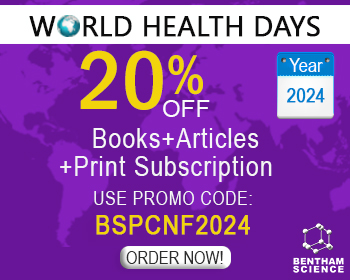Abstract
Background: Background: Lycium europaeum L. is a medicinal and edible Mediterranean halophyte spiny shrub, however, studies regarding its biological properties focused mainly on its aerial organs.
Objective: The objective of the present work was to make a comparative evaluation of the in vitro antioxidant and enzyme inhibitory activities of ethanol extracts and fractions (chloroform, ethyl acetate, n-butanol and aqueous) from roots and leaves of L. europaeum, along with its total phenolic, flavonoid and tannin contents.
Methods: The antioxidant activity was evaluated by the 1,1-diphenyl-2-picrylhydrazyl (DPPH), 2,2’-azino-bis-3-ethylbenzthiazoline-6-sulphonic acid (ABTS), superoxide radical, β-carotene bleaching, cupric reducing and ferric reducing activity methods.
Results: The n-butanol fraction from roots had the highest antioxidant activity in all the assays, and was also the most active against acetylcholinesterase, butyrylcholinesterase and urease (IC50 values of 92.63, 118.26 and 135.60 μgmL-1, respectively). This fraction showed a high level of total phenolic, flavonoid and tannin contents.
Conclusion: The results suggest L. europaeum, especially its roots, as a candidate to be further explored as a source of bioactive products.
Keywords: Lycium europaeum L., bioactive plant-derived products, cholinesterase inhibition, enzymatic inhibition, phenolics, flavonoids, urease.
[http://dx.doi.org/10.1016/S0378-8741(03)00051-5] [PMID: 12686446]
[http://dx.doi.org/10.1002/ptr.2392] [PMID: 18618525]
[http://dx.doi.org/10.1006/mpev.2001.0921] [PMID: 11341807]
[http://dx.doi.org/10.1016/j.jep.2017.10.010] [PMID: 29042287]
[http://dx.doi.org/10.1111/j.1095-8339.2006.00549.x]
[http://dx.doi.org/10.1016/0378-8741(94)90093-0] [PMID: 7990499]
[http://dx.doi.org/10.1007/s10531-006-9016-y]
[http://dx.doi.org/10.1016/j.foodchem.2017.03.019] [PMID: 28407975]
[http://dx.doi.org/10.1093/ecam/nel034] [PMID: 16786053]
[http://dx.doi.org/10.1007/s12231-017-9368-0]
[http://dx.doi.org/10.5897/AJMR12.1875]
[http://dx.doi.org/10.1007/s10658-018-1469-9]
[http://dx.doi.org/10.5530/ctbp.2021.1.9]
[http://dx.doi.org/10.1080/01635581.2015.1017054] [PMID: 25825796]
[http://dx.doi.org/10.1080/14786419.2019.1666386] [PMID: 31542954]
[http://dx.doi.org/10.1016/S0076-6879(99)99017-1]
[http://dx.doi.org/10.1021/jf0343074] [PMID: 14558771]
[http://dx.doi.org/10.1016/j.foodchem.2010.05.011]
[http://dx.doi.org/10.1038/1811199a0]
[http://dx.doi.org/10.1016/S0891-5849(98)00315-3] [PMID: 10381194]
[http://dx.doi.org/10.1016/0378-5173(90)90201-E]
[http://dx.doi.org/10.1016/j.fct.2011.03.019] [PMID: 21419821]
[http://dx.doi.org/10.5264/eiyogakuzashi.44.307]
[http://dx.doi.org/10.1007/s00604-007-0777-0]
[http://dx.doi.org/10.1016/j.indcrop.2013.12.043]
[http://dx.doi.org/10.1016/j.foodchem.2013.04.123] [PMID: 23870944]
[http://dx.doi.org/10.1016/0006-2952(61)90145-9] [PMID: 13726518]
[http://dx.doi.org/10.1016/j.bmc.2017.11.028] [PMID: 29183662]
[http://dx.doi.org/10.1016/j.biopha.2017.09.035] [PMID: 28946192]
[http://dx.doi.org/10.1016/j.jksus.2018.03.018]
[http://dx.doi.org/10.1016/j.biortech.2007.07.067] [PMID: 17935981]
[http://dx.doi.org/10.1016/j.foodchem.2014.11.114] [PMID: 25529722]
[http://dx.doi.org/10.1016/j.foodchem.2011.09.020]
[http://dx.doi.org/10.1590/S0100-40422010001000033]
[http://dx.doi.org/10.1016/S0924-2244(00)89140-2]
[http://dx.doi.org/10.1016/j.ijbiomac.2013.05.020] [PMID: 23732331]
[http://dx.doi.org/10.4102/jomped.v2i1.31]
[http://dx.doi.org/10.1016/j.fct.2016.10.004] [PMID: 27725206]
[http://dx.doi.org/10.1080/10496475.2018.1446204]
[http://dx.doi.org/10.1016/j.fct.2018.01.054] [PMID: 29448090]
[http://dx.doi.org/10.3724/SP.J.1009.2010.00349]
[http://dx.doi.org/10.1016/j.jsps.2010.02.004] [PMID: 24115900]
[PMID: 29441920]
[http://dx.doi.org/10.1016/j.cbi.2008.06.002] [PMID: 18602908]
[http://dx.doi.org/10.1371/journal.pone.0088076] [PMID: 24505383]
[http://dx.doi.org/10.1080/14786419.2015.1062378] [PMID: 26291657]
[http://dx.doi.org/10.1016/j.foodchem.2017.05.043] [PMID: 28554615]




























